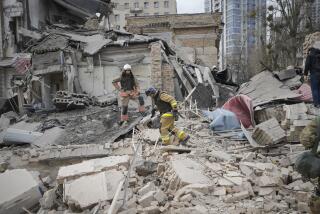Senate May Oppose More B-2 Funds, Nunn Tells Bush : Defense: GOP support for Stealth bombers is eroding, the influential lawmaker says. The issue becomes complicated by being linked to ‘Star Wars.’
WASHINGTON — Sen. Sam Nunn (D-Ga.), an influential supporter of the B-2 Stealth bomber, warned President Bush on Friday there is a 50-50 chance that the Senate will follow the House and vote against further production of the radar-eluding plane.
“I think it’s got an uphill fight,” said Nunn, chairman of the Senate Armed Services Committee. “There’s a lot of work for the President to do on the Republican side,” where opposition to the B-2 program is growing.
Nunn’s panel, which is completing work on a $291-billion defense authorization bill for 1992, voted 11 to 8 Thursday to grant Bush’s request to add four more B-2s to the 15 that have been funded already. The Air Force wants eventually to buy a total of 75 of the advanced-technology bombers, which are produced at Northrop Corp. plants in Los Angeles. They cost about $870-million each.
Sen. John W. Warner (R-Va.) said the issue also has been complicated by the concern of some Republican lawmakers that the Pentagon is pushing the B-2 harder than the Strategic Defense Initiative, or “Star Wars,” anti-missile program.
Warner, the ranking Republican on the committee, said at a news conference with Nunn that some GOP members are insisting that the Administration link the B-2 and “Star Wars” in a single strategic weapons package.
Nunn and Warner said the committee debated the “Star Wars” program in a spirited, six-hour session behind closed doors Thursday without coming to a resolution.
By a vote of 10 to 9, it rejected a bipartisan plan to defer deployment of “Brilliant Pebbles,” a space-based system of interceptor rockets sought by Bush. But the committee leaders said they will continue to pursue the Strategic Defense Initiative, which calls for developing a ground-based missile defense system, while changes are sought in a 1972 U.S.-Soviet treaty barring space-based defenses.
Nunn said the committee will meet again next Tuesday. No matter what “Star Wars” strategy it adopts, the committee will authorize spending at least $4.5 billion on the program in the fiscal year that begins Oct. 1, he said.
Though less than the $5.2 billion requested by Bush, that would be significantly more than the $2.7 billion approved by the House, which cut all funds for “Brilliant Pebbles.”
The Senate panel has completed action on all other items in the bill, including a recommendation that a presidential commission spend 14 months studying whether to assign women to combat roles. The House, in its defense bill, voted last May to allow women to fly combat missions.
Nunn, noting that women did “a superb job” in the Persian Gulf War, said he was inclined initially to support the House position but now believes there are a number of unanswered questions that must be resolved. “We have to think through these questions as a society as well as . . . from a military point of view,” he said.
That position was characterized as “absolute hogwash” by Sen. William V. Roth Jr. (R-Del.). “This issue needs no further study,” Roth said. “As we’ve seen in the Persian Gulf, women have already proven themselves capable of flying in combat situations.”
He promised a floor fight on the matter.
On one of several issues that could prompt a veto by Bush, the Senate committee called for reducing the National Guard and military reserves by 33,000 personnel rather than the 107,526 proposed by Defense Secretary Dick Cheney. The House voted to add 1,065 members in what Cheney has criticized as a budget-busting move out of proportion with cuts in active duty forces.
The Senate committee also called for funding four C-17 transport planes, instead of the six requested by Bush and approved by the House. The Senate panel said the move would save $600 million “while awaiting a successful first flight” of the troubled plane, which is designed to carry heavier equipment and use shorter runway space than existing aircraft.
More to Read
Get the L.A. Times Politics newsletter
Deeply reported insights into legislation, politics and policy from Sacramento, Washington and beyond. In your inbox three times per week.
You may occasionally receive promotional content from the Los Angeles Times.










